History holds court at Hampton Plantation, one of the many outposts of the Rice Kingdom. A colonial era Big House with tours, fine grounds and gardens, historic visits by famous Americans (George Washington, Francis Marion), famous residents Eliza Lucas Pinckney and Archibald Rutledge (the first SC poet laureate) – all these elements and more have been attracting visitors for years. Yet under the benevolent plantation veneer lies another reality, that of the lives of enslaved African Americans. Their story is actively being brought to light at Hampton Plantation State Historic Site through various forums.
For two weeks per year in the past five years, archaeologists have been excavating the site of a slave settlement building at Hampton Plantation. Led by David Jones, state parks archaeologist, and Stacey Young, site archaeologist, a collection of state employees, students, and volunteers have been carefully unearthing this structure, dating from the late 1700’s and 1800’s. It had remained hidden until the site and its brick foundations were discovered in the recent past.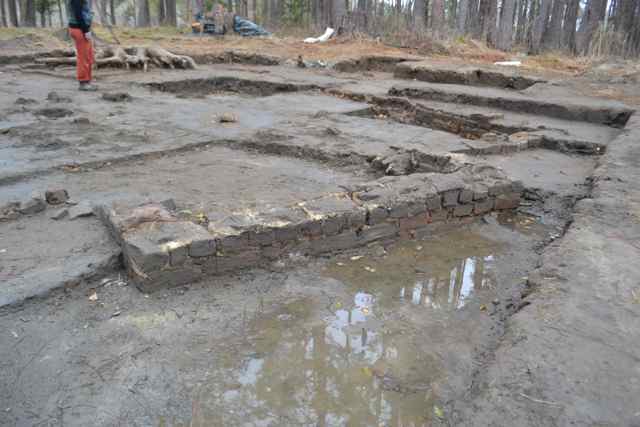 Having received an invitation from Vennie Deas Moore, cultural historian, to join the volunteer contingent last fall for a day, I returned this March 6, the next to last day of the fieldwork segment of the project.
Having received an invitation from Vennie Deas Moore, cultural historian, to join the volunteer contingent last fall for a day, I returned this March 6, the next to last day of the fieldwork segment of the project.
After helping the crew bail out the tarp covering the site, I assumed the position at one of the screens for sifting artifacts from dirt.
Mac and Vennie at one of the screens
I sifted dirt provided by site archaeologist, Stacey Young, and taken from the final level of one of the units. The dirt was very wet, so trying to push the dirt through the screen created mud balls. I was warned to watch out for glass beads hiding in the mud. Throughout the day, the main artifacts coming to light were fragments of brick, ceramics including colonoware, glass, pipe stems, and forged nails. 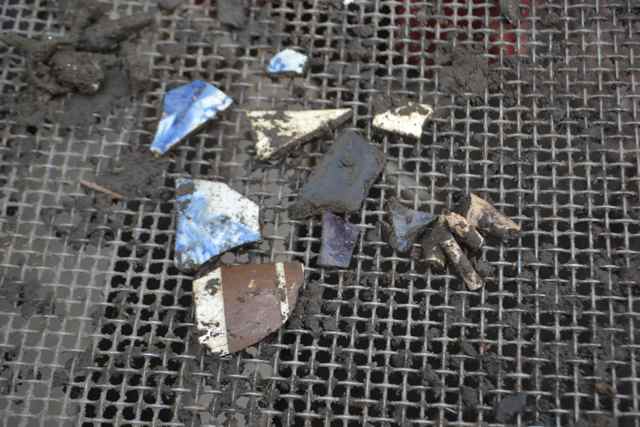 Stacey and others were completing the last of the excavation – others cleaned up the excavation for photography: a boom truck arriving the following day would provide the overhead platform.
Stacey and others were completing the last of the excavation – others cleaned up the excavation for photography: a boom truck arriving the following day would provide the overhead platform.
Vennie expressed nostalgia and sadness related to the end of this project. The timing coincided with two very important 150th anniversaries: the end of slavery in Charleston and the Lowcountry (see Death of Slavery in Charleston), and the assassination of Abraham Lincoln (covered fully in the March issue of Smithsonian). This archaeological project was just one effort of many at Hampton to increase education about slavery and the people involved. New signage had been erected since my past visit in the fall, and would help visitors see the wetland just beyond the site in a new light – the place where workers toiled cultivating rice for perhaps 150 years – “Mainfield”.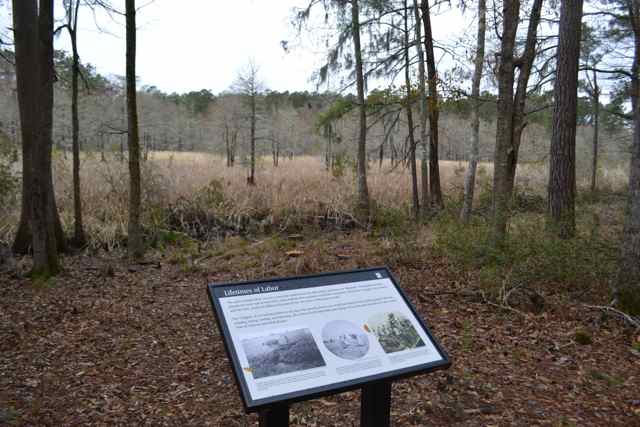
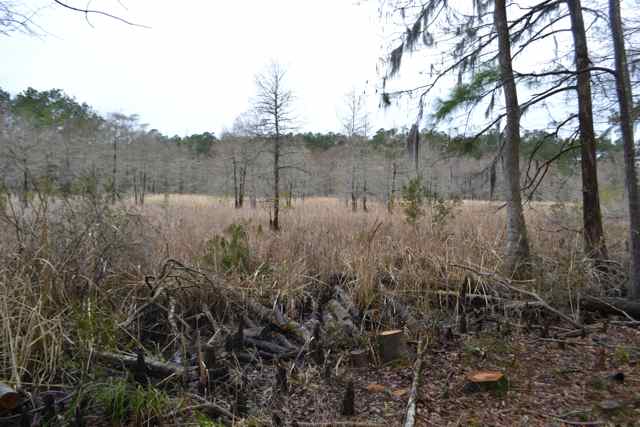 Another innovative interpretative device will be a glass panel to project an artist’s image of the slave dwelling over the site.
Another innovative interpretative device will be a glass panel to project an artist’s image of the slave dwelling over the site.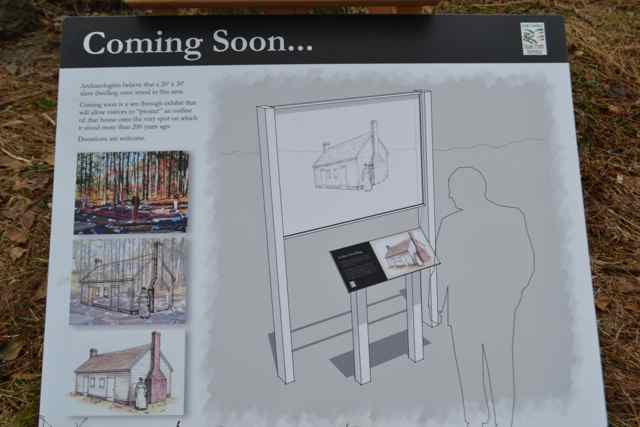 Opportunities abound for further archaeology at Hampton, since testing revealed postholes and artifacts of other structures in the woods nearby. Perhaps more importantly, archaeologists have found south of the plantation house evidence of older slave dwellings.
Opportunities abound for further archaeology at Hampton, since testing revealed postholes and artifacts of other structures in the woods nearby. Perhaps more importantly, archaeologists have found south of the plantation house evidence of older slave dwellings.
Vennie’s feelings may have been in part a function of the happy camaraderie of the collective of people working on this project. David Jones in particular infused the area with his friendliness and humor in interacting with all. In fact, visitors trickling over to the site were greeted by either David or Stacey stepping away from the tasks at hand to describe and interpret what was going on, as opposed to keeping the public at a distance. This openness allowed me to join in as an amateur (though no stranger to archaeological fieldwork) in order to help out and interact with all. Stacey mentioned as I prepared to screen another bucket of dirt that there was a “goodie” in this load. As I sifted through it, she mentioned that it was a button; as I got much of the dirt through the screen I wondered if I would be sent packing at failing to find the object. Finally it appeared, and I dropped the bronzed-tinged object into its appropriate ziplock bag.
Receiving permission to pull some of the artifacts out of the bag for photos, I wiped some of the mud off the button, but found no mounting holes for this object measuring about 3/4 the diameter of a silver dollar. Washing more mud off in a puddle, the button transformed into a coin. 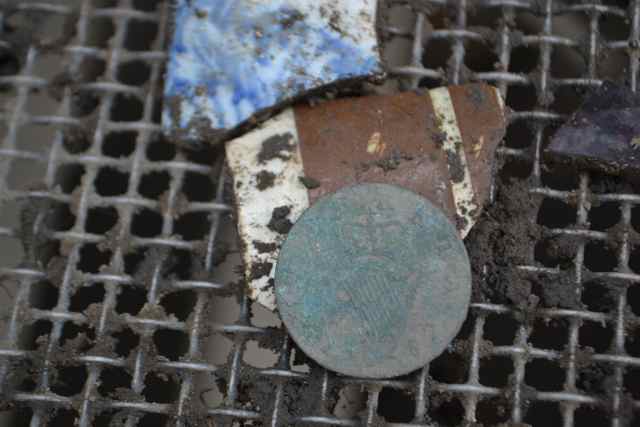 Sharing the find with Stacey, we began to decipher the print and images, and one of the students on site looked even closer with a magnifier. Text minted into the coin included “Georgivs III Rex” and “1782”. Noting her curiosity, I asked if she was interested in researching further once she returned home, and sharing her findings. Before long, I noticed she had already pulled up images on her smart phone. Looking myself later, I seemed to find a match – a half-penny minted in Dublin.
Sharing the find with Stacey, we began to decipher the print and images, and one of the students on site looked even closer with a magnifier. Text minted into the coin included “Georgivs III Rex” and “1782”. Noting her curiosity, I asked if she was interested in researching further once she returned home, and sharing her findings. Before long, I noticed she had already pulled up images on her smart phone. Looking myself later, I seemed to find a match – a half-penny minted in Dublin.
Unlike collectors, archaeologists utilize the context of the objects in the soil layers, along with other data, to analyze and interpret. This coin captured my attention, and generated a variety of questions. The laboratory portion of the project has yet to begin, and analysis and reporting will follow. Those findings will provide a chapter in Hampton’s history for historians and the public to study. The plantation’s rich heritage contains more chapters for discovery and documentation. The current and future efforts will help us better understand the lives of people of whom we have only had brief glimpses.
Bob,
That is very interesting and exciting work. Deb and I always take a trip in the Winyaw bay from Georgetown visiting many rice plantations when on vacation down that way every year. Finding a coin would give me the itch to get a metal detector and comb Bulls Island!
Many other rice plantations also are interpreting the lives of the enslaved – Hobcaw Barony, Brookgreen Gardens, Middleton, Magnolia, etc. But hold off on taking that metal detector to Bulls Island – it is illegal to take antiquities from the refuge. You can grab beautiful shells instead.
In that case the only wealth I’ll be taking from Bulls Island is sand dollars!
Ha ha..
Ron
Thanks for sharing this incredible story – can’t wait to visit the location!
Fantastic place – a great resource for SC and the nation. Put it on your list on your next visit to the Lowcountry.
Bob,
I visited Hampton Plantation last year during the Bulls Bay Nature Festival, and I’m in the process of planning a day for the walkers & hikers that includes Santee Delta or Santee Coastal NWR and Hampton Plantation. I saw the tarps when I was there, and read about the archeological project. How awesome! Thank you for sharing your experience and the discoveries!
There are some great walks up there. Hampton has a nature trail that goes all the way around Mainfield and is well marked. There is also Santee Delta WMA that has a much longer walk around the dikes. Do that walk before the bugs come out in force. Same for the 6 mile loop hike at Santee Coastal Reserve.
Great writing Bob! I enjoyed reading about your experience at the site. It’s always good to hear how others are impacted by our work and the history of Hampton. Thanks for coming out-I appreciate your help and willingness to jump in and help us bail water!
Stacey
Thanks again for including me, Stacey. I know there is lots more to be revealed about Hampton, and your work will contribute greatly to increasing our knowledge. Looking forward to future work at Hampton.